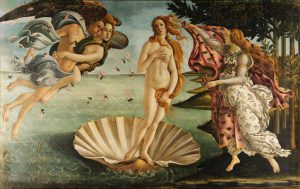第二十章 人間の価値の中の性の位置 n.6:
 包括的な性倫理は,性をただ単に自然な飢えであり,危険の潜在的源泉とみなすだけで済ますわけにいかない。この二つの見方はともに重要であるが,性は人生における最上の財産のいくつかと結びついていることを想い出すこと(記憶していること)の方がもっと重要である。最重要と思われる3つの財産は,叙情的恋愛 (lyric love 感情豊かな恋愛),結婚の幸福,および芸術である。(注:もちろん,性と関連のあるものについてだけあげている。) 叙情的恋愛と結婚については,既に述べている。芸術は性と無関係だと考える人もいるが,この見解の信奉者人は,今は,以前(昔)よりも少なくなっている。あらゆる種類の美的創造への衝動は,必ずしも直接的あるいは明白なかたちではないにしても,心理的に見れば求愛(courtship)と結びついていることはかなりあきらかである。だが,直接的でも明白でもないからと言って,それだけ結びつきがより少ない,ということはない(のである)。
包括的な性倫理は,性をただ単に自然な飢えであり,危険の潜在的源泉とみなすだけで済ますわけにいかない。この二つの見方はともに重要であるが,性は人生における最上の財産のいくつかと結びついていることを想い出すこと(記憶していること)の方がもっと重要である。最重要と思われる3つの財産は,叙情的恋愛 (lyric love 感情豊かな恋愛),結婚の幸福,および芸術である。(注:もちろん,性と関連のあるものについてだけあげている。) 叙情的恋愛と結婚については,既に述べている。芸術は性と無関係だと考える人もいるが,この見解の信奉者人は,今は,以前(昔)よりも少なくなっている。あらゆる種類の美的創造への衝動は,必ずしも直接的あるいは明白なかたちではないにしても,心理的に見れば求愛(courtship)と結びついていることはかなりあきらかである。だが,直接的でも明白でもないからと言って,それだけ結びつきがより少ない,ということはない(のである)。
性的衝動が芸術的表現をとるようになるためには,いくつかの条件が必要である。まず,芸術的才能がなければならない。しかし,芸術的才能は,特定の民族の内においても,ある時代には普通(凡庸)であり,別の時代には例外(非凡)であるかのように思われる。このことから,生まれつきの才能に対立するものとしての環境が,芸術的衝動の発達に重要な役割を演じている,という結論を出すほうが安全である。(芸術家には)ある種の自由がなければならないが,それは,芸術家に報酬を与えることを趣旨とする種類の自由ではなく,芸術家を強いたり勧めたりして,彼を俗物(ペリシテ人)にしてしまうような習慣に追いやらないことを趣旨とする種類の自由である。
ユリウス二世(注:ローマ教皇)がミケランジュロを拘束した時,彼は,芸術家が必要とする種類の自由は一切妨げなかった。ユリウス二世がミケランジュロを拘束したのは,彼を重要な人物と考えたからであり,教皇(自分)より下の階級の者が自分を攻撃する(無礼を働くこと)ことに少しも耐えられなかった(のである)。けれども,芸術家が金持ちのパトロンや市会議員に卑屈に追従させられたり(注:原著では kowtow が kotow とミス・スペル),自分の作品を彼らの美的基準にむりやり合わせられるような場合は,その芸術的自由は失われる。そうして,社会的・経済的な迫害を恐れることによって,耐えがたくなった結婚生活を続けることを強いられる場合は,芸術的創作に必要なエネルギーを奪われる。因習的に道徳的であった社会は,偉大な芸術を生んできていない。これを生んできた社会は,アイダホ州(米国)なら断種しそうな人びとから成り立っていた。(注:第18章「優生学」のアイダホに関する記述を参照 https://russell-j.com/beginner/MM18-040.HTM)
(注:この一文「Those which have, have been composed of men such as Idaho would sterilize. 」は,省略もあって難しい。丁寧にかけば,Those societies which have produced have been composed of men such as Idaho would sterlize, といったものであろう。)
現在,アメリカは,芸術的才能の大部分をヨーロッパから輸入している。ヨーロッパでは,いまだ,自由が(わずかながら)生き残っているからである。しかし,ヨーロッパもアメリカナイズされてきて,(芸術的才能は)黒人に頼らなければならなくなってきている。芸術の最後の棲みかは,チベット高原でないとすれば,コンゴ上流のどこかになりそうに思われる。しかし,芸術が最終的に消滅するのは,そう遠い先のことではありえない。なぜなら,アメリカが外国人の芸術家に物惜しみしないで用意している報酬は,否応なしに,彼らの芸術の死をもたらすに違いないからである。
Chapter XX: The Place of Sex among Human Values, n.6
A comprehensive sexual ethic cannot regard sex merely as a natural hunger and a possible source of danger. Both these points of view are important, but it is even more important to remember that sex is connected with some of the greatest goods in human life. The three that seem paramount are lyric love, happiness in marriage, and art. Of lyric love and marriage we have already spoken. Art is thought by some to be independent of sex, but this view has fewer adherents now than it had in former times. It is fairly clear that the impulse to every kind of aesthetic creation is psychologically connected with courtship, not necessarily in any direct or obvious way, but none the less profoundly. In order that the sexual impulse may lead to artistic expression, a number of conditions are necessary. There must be artistic capacity ; but artistic capacity, even within a given race, appears as though it were common at one time and uncommon at another, from which it is safe to conclude that environment, as opposed to native talent, has an important part to play in the development of the artistic impulse. There must be a certain kind of freedom, not the sort that consists in rewarding the artist, but the sort that consists in not compelling him or inducing him to form habits which turn him into a Philistine. When Julius II imprisoned Michelangelo, he did not in any way interfere with that kind of freedom which the artist needs. He imprisoned him because he considered him an important man, and he would not tolerate the slightest offence to him from anybody whose rank was less than papal. When, however, an artist is compelled to kowtow to rich patrons or town councillors, and to adapt his work to their aesthetic canons, his artistic freedom is lost. And when he is compelled by fear of social and economic persecution to go on living in a marriage which has become intolerable, he is deprived of the energy which artistic creation requires. Societies that have been conventionally virtuous have not produced great art. Those which have, have been composed of men such as Idaho would sterilize. America at present imports most of its artistic talent from Europe, where, as yet, freedom lingers ; but already the Americanization of Europe is making it necessary to turn to the negroes. The last home of art, it seems, is to be somewhere on the Upper Congo, if not in the uplands of Tibet. But its final extinction cannot be long delayed, since the rewards which America is prepared to lavish upon foreign artists are such as must inevitably bring about their artistic death.
出典: Marriage and Morals, 1929.
詳細情報:https://russell-j.com/beginner/MM20-060.HTM
